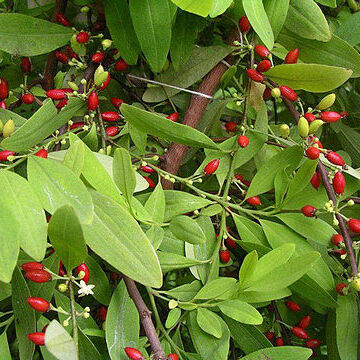Bush or shrub c. 1-3 m. Lenticels on the branches minute. Leaves abundant along the twigs, not soon falling, obovate-oblong, bright green above, paler and glaucous beneath, c. (2-)3-6(-7) by 1-3 cm; rounded or sometimes emarginate, always with a mucronate tip or notch, attenuate at the base; midrib rather prominent beneath, specially at the base, nerves numerous, on both surfaces equally distinct, venation delicately anastomosing, central part included between the areolation lines slightly concave and of a paler colour on both surfaces; petiole thin, c. 3-7 mm. Stipules green, triangular, shorter or half as long as the petiole, c. 2.5-4 by 2-3 mm, slightly bicarinate, persistent, on old branches brown, top emarginate, 2-toothed, margin more or less fimbriate. Ramenta none or occasionally a few. Flowers in clusters of 1-4(-8). Bracteoles green, deltoid, acuminate, scarious, up to c. 2.5 by 1 mm, margin delicately fimbriate. Pedicels thickened, c. 5-10 mm. Calyx green, the tube 1-1.5 mm, lobes triangular-ovate, acuminate, c. 1.5-2 by 1 mm. Petals white or greenish-white, oblong, convex c. (3.5-)4(-5) by 2 mm; ligule 3-lobed, with crisped lobes, half as long as the blade of the petal; claw c. 1/5-1/4 the length of the petal. Brachystylous flowers. Staminal tube pale green c. 1 mm. Stamens equal, filaments c. 3½-5½ mm, anthers c. 0.5 by ⅔ mm. Ovary distinctly longer than the staminal tube, c. 2 by 1 mm; styles free, c. 1 mm. Dolichostylous flowers. Staminal tube 1 mm. Stamens unequal, episepalous filaments ½-¾-1 mm, epipetalous ones 0.5-1.5-2 mm, anthers 0.75-0.5 by 0.5-0.25 and 0.5 by 0.25 mm respectively. Ovary longer than the staminal tube, c. 1½ by 1 mm; styles free, c. 2-3 mm. Drupe red, elliptic-oblong, in the fresh state 9-11 by 4-5 mm; stone narrower, pointed, obtusely trigonous, with 4-6 ribs and furrows, c. 8-10 by 3-4 mm; sterile cells hardly distinct, fertile cell almost triangular in section. Seed with 3 distinct ribs; endosperm abundant; embryo central, small, c. 6-7 by 1 mm, flattened; cotyledons lanceolate, c. 3-4 mm; radicle c. 2-3 by 0.5 mm.
More
Shrubs or small trees. Stipules triangular, 1.5-3 mm, margin often entire. Leaves alternate, simple; petiole 4-7 mm; leaf blade obovate to narrowly elliptic, 1.2-4.7 × 1-1.8 cm, midvein adaxially impressed, secondary veins anastomosing into an obvious intramarginal vein in each side of midvein, base attenuate, margin entire, apex obtuse to retuse and with a mucro. Flowers solitary or fascicled, small. Pedicel to 4 mm at anthesis. Sepals 5, ca. 1.5 mm, basally connate. Petals 5, whitish yellow, ovate-oblong, 3-3.5 mm, with 2 ligules on inner face at base. Stamens 10; filament basally connate into a tube, 2-4 mm. Ovary globose to oblong, 1-3.5 mm, 3-locular, with 1 ovule in only fertile locule; styles distinct, 1-3 mm, persistent. Mature drupe red, oblong, 7-8 × ca. 3 mm, with 5 longitudinal ribs, 1-seeded. Fl. most of year but mostly Feb-Mar, fr. May-Dec.
A shrub or small tree. The leaves are simple and alternate. They are narrowly oval and 1-5 cm long by 1-2 cm wide. Flowers can occur singly or in groups. They are small and whitish yellow. The fruit are red and oblong. They are 7-8 mmlong by 3 mm wide.

